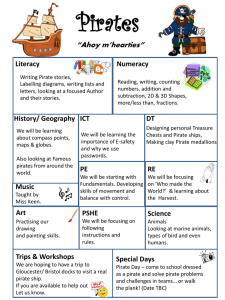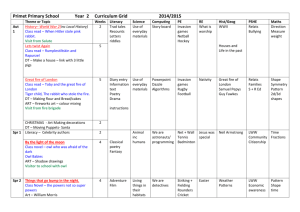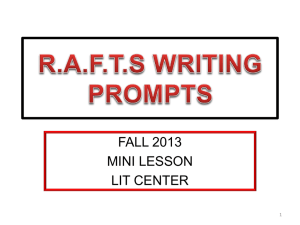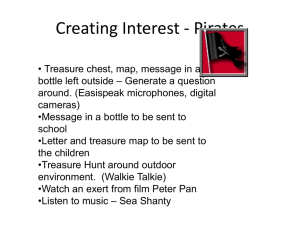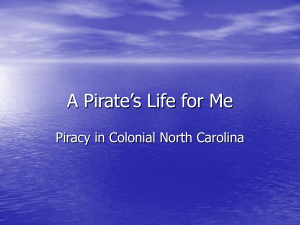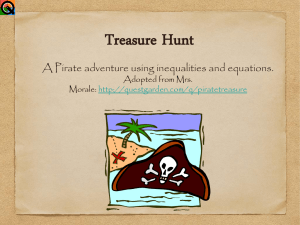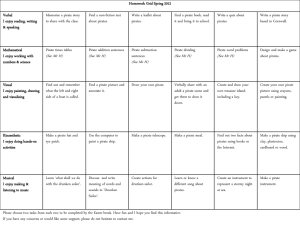Infants Long term plan 2015-2016
advertisement
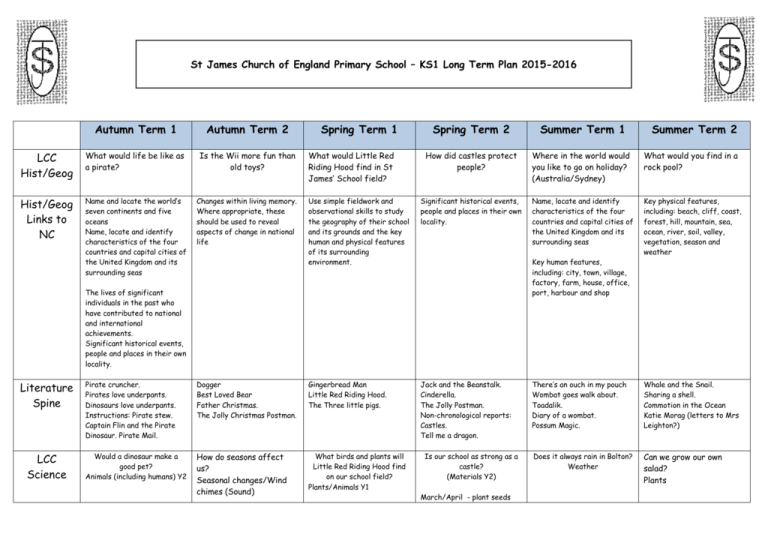
St James Church of England Primary School – KS1 Long Term Plan 2015-2016 Autumn Term 1 Autumn Term 2 LCC Hist/Geog What would life be like as a pirate? Is the Wii more fun than old toys? Hist/Geog Links to NC Name and locate the world’s seven continents and five oceans Name, locate and identify characteristics of the four countries and capital cities of the United Kingdom and its surrounding seas Changes within living memory. Where appropriate, these should be used to reveal aspects of change in national life Spring Term 1 Spring Term 2 Summer Term 1 How did castles protect people? Where in the world would you like to go on holiday? (Australia/Sydney) What would you find in a rock pool? Use simple fieldwork and observational skills to study the geography of their school and its grounds and the key human and physical features of its surrounding environment. Significant historical events, people and places in their own locality. Name, locate and identify characteristics of the four countries and capital cities of the United Kingdom and its surrounding seas Key physical features, including: beach, cliff, coast, forest, hill, mountain, sea, ocean, river, soil, valley, vegetation, season and weather Jack and the Beanstalk. Cinderella. The Jolly Postman. Non-chronological reports: Castles. Tell me a dragon. What would Little Red Riding Hood find in St James’ School field? Key human features, including: city, town, village, factory, farm, house, office, port, harbour and shop The lives of significant individuals in the past who have contributed to national and international achievements. Significant historical events, people and places in their own locality. Literature Spine LCC Science Pirate cruncher. Pirates love underpants. Dinosaurs love underpants. Instructions: Pirate stew. Captain Flin and the Pirate Dinosaur. Pirate Mail. Dogger Best Loved Bear Father Christmas. The Jolly Christmas Postman. Gingerbread Man Little Red Riding Hood. The Three little pigs. Would a dinosaur make a good pet? Animals (including humans) Y2 How do seasons affect us? Seasonal changes/Wind chimes (Sound) What birds and plants will Little Red Riding Hood find on our school field? Plants/Animals Y1 Is our school as strong as a castle? (Materials Y2) March/April - plant seeds Summer Term 2 There’s an ouch in my pouch Wombat goes walk about. Toadalik. Diary of a wombat. Possum Magic. Whale and the Snail. Sharing a shell. Commotion in the Ocean Katie Morag (letters to Mrs Leighton?) Does it always rain in Bolton? Weather Can we grow our own salad? Plants Science Links to NC Art & Design All living things and their habitats Pupils should be taught to: explore and compare the differences between things that are living, dead, and things that have never been alive identify that most living things live in habitats to which they are suited and describe how different habitats provide for the basic needs of different kinds of animals and plants, and how they depend on each other identify and name a variety of plants and animals in their habitats, including microhabitats describe how animals obtain their food from plants and other animals, using the idea of a simple food chain, and identify and name different sources of food. Seasonal change: observe changes across the four seasons observe and describe weather associated with the seasons and how day length varies. Junk model pirate ships. Pirate’s flag. Paper plate faces. Artist in residence. Make their own parrot. (paper plate) Ship wreck collage. Cress head pirates. Pirate Stew Design/Make/Evaluate a moving toy. Sock puppets. Moving pictures. Make robots (DT) Junk model pirate ships. Pirate’s flag. Paper plate faces. Artist in residence. Design/Make/Evaluate a moving toy. Sock puppets. Moving pictures. Sound Pupils should be taught to: observe and name a variety of sources of sound, noticing that we hear with our ears recognise that sounds get fainter as the distance from the sound source increases. Plants: identify and name a variety of common plants, including garden plants, wild plants and trees, and those classified as deciduous and evergreen Everyday materials Pupils should be taught to: distinguish between an object and the material from which it is made identify and name a variety of everyday materials, including wood, plastic, glass, metal, water, and rock describe the simple physical properties of a variety of everyday materials compare and group together a variety of everyday materials on the basis of their simple physical properties find out how the shapes of solid objects made from some materials can be changed by squashing, bending, twisting and stretching. Seasonal change: observe changes across the four seasons observe and describe weather associated with the seasons and how day length varies. Story telling peg doll basket. Shadow Puppets. Andy Goldsworth ephemeral art. Design/Make gingerbread men. Three little pigs houses to blow over? Junk model castle. Printing shields/patterns. Dragon scales/Dragons/Eggs Chinese dragon (large) Dragons Paper plate dragons. Australian art (aboriginal) Pointilism Australian Landmark (Collage). Australian animals (clay) Friendship pebbles. Drawing shells (still life) Rock pool collage. Colour mixing. Wind chimes. Beach hut pictures.. Shell prints (Little canvases) Story telling peg doll basket. Shadow Puppets. Andy Goldsworth ephemeral art. Junk model castle. Printing shields/patterns. Dragon scales/Dragons/Eggs Chinese dragon (large) Australian art (aboriginal) Pointilism Australian Landmark (Collage). Friendship pebbles. Drawing shells (still life) Rock pool collage. Colour mixing. basic structure of a variety of common flowering plants, including roots, stem/trunk, leaves and flowers. Animals, including humans Pupils should be taught to: identify and name a variety of common animals that are birds, fish, amphibians, reptiles, mammals and invertebrates identify and name a variety of common animals that are carnivores, herbivores and omnivores describe and compare the structure of a variety of common animals (birds, fish, amphibians, reptiles, mammals and invertebrates, and including pets) Plants Pupils should be taught to: observe and describe how seeds and bulbs grow into mature plants find out and describe how plants need water, light and a suitable temperature to grow and stay healthy. Animals, including humans describe the importance for humans of exercise, eating the right amounts of different types of food, and hygiene. Computing Design Technology Make their own parrot. (paper plate) Ship wreck collage. Cress head pirates. Pirate Stew Make robots (DT) Design/Make gingerbread men. Three little pigs houses to blow over? Dragons Paper plate dragons. Australian animals (clay Wind chimes. Beach hut pictures.. Shell prints (Little canvases Music PE Games: Beanbags/quoits Dance: Link to topic RE God & Creation WOW moments Pirate dress up day Make a pirate ship Make a pirate trailer Games: Large Balls Games: Throwing & Catching Gymnastics: LCP Activities 1 Lessons 1-6 Christmas Gifts & Gift Bringers Dance: Link to Topic Interview a grandparent. Bolton library Service to bring toys. Monitor a tree in the school grounds. Making bread/gingerbread/porridge. Food tasting. Grow beanstalks/strawberries. Den building/Forest school visit (Park rangers) Jesus was special Games: Large Balls Games: Throwing & Catching Gymnastics: Activities 1 Lessons 7-12 Easter celebrating new life Dance: Link to Topic Visit a castle. Clitheroe Make castles. Dragon eggs in class. Australia Day. Interview an Australian. Australia school links. Baptism – Non-Christian faith link Games: Bats and Balls Gymnastics: Refine skills taught Jesus friend to everyone Pond dipping./Martin Mere. (Formby sands)
